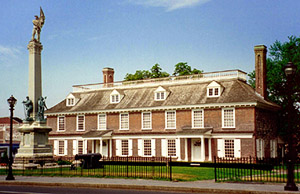- Philipse Manor Hall State Historic Site
Infobox nrhp
name = Philipse Manor Hall
nrhp_type = nhl

caption = The Manor house
location = Yonkers
nearest_city =
lat_degrees = 40 | lat_minutes = 56 | lat_seconds = 08 | lat_direction = N
long_degrees = 73 | long_minutes = 53 | long_seconds = 59 | long_direction = W
area =
built = 1682
architect =Frederick Philipse
architecture =
designated=November 5 ,1961 cite web|url=http://tps.cr.nps.gov/nhl/detail.cfm?ResourceId=426&ResourceType=Building
title=Philipse Manor Hall|date=2007-09-18|work=National Historic Landmark summary listing|publisher=National Park Service]
added =October 15 ,1966 cite web|url=http://www.nr.nps.gov/|title=National Register Information System|date=2007-01-23|work=National Register of Historic Places|publisher=National Park Service]
visitation_num =
visitation_year =
refnum = 66000584
mpsub =
governing_body =New York State Office of Parks, Recreation and Historic Preservation Philipse Manor Hall State Historic Site is a historic house museum located in Yonkers,
New York . It is Westchester County’s oldest standing building, and is currently owned and operated by theNew York State Office of Parks, Recreation and Historic Preservation .It is located at Warburton Avenue and Dock Street.
History
The southwest corner, the oldest part of the structure, was built around 1682 by Dutch-born carpenter and trader
Frederick Philipse , a son-in-law ofStephanus Van Cortlandt , who by the time of his death had amassed a 52,000-acre (208 km²) estate that encompassed the entire modern city of Yonkers, as well as several otherHudson River towns.During Philipse's life, the building was used primarily as a stopover point on the long journey up and down the river between his home in
New Amsterdam and the northern parts of his estate. His grandson,Frederick Philipse II , and his great-grandson,Frederick Philipse III , successively enlarged and enhanced the building, making it the primary family residence.On
November 28 ,1776 , nearly five months after the signing of the Declaration of Independence and the start of theAmerican Revolution , Frederick Philipse III and over 200 of his contemporaries signed a document declaring their allegiance to the British crown and their unwillingness to support the Revolutionary cause. (Modern historians often refer to this document as a “Declaration of Dependence.”) Because of his Loyalism, Philipse was branded a traitor and placed under arrest on orders signed by GeneralGeorge Washington . He was held inConnecticut for a time, but was given special permission to travel back to Yonkers to settle his affairs on the condition that he not aid the British cause. In violation of his parole, he and his family fled to British-occupiedNew York City and later toGreat Britain , leaving their estate and Philipse Manor Hall behind.Philipse Manor Hall was sold at public
auction following the Revolution, and occupied by various families throughout the 19th century. In 1868, the building became Yonkers' municipal center (as Village Hall, and later, asCity Hall ) and remained such until 1908. During this period, an elaborate monument to those Yonkers natives who had died during theAmerican Civil War was installed on the east lawn (1891).By 1908, the growing complexity of city government had made the building nearly obsolete as a government center. Public meetings were held, and options such as adding wings onto the building and tearing it down outright were discussed. The question became moot when Eva Smith Cochran, matriarch of a wealthy local carpet milling family, stepped in and donated $50,000 to the city as a nominal reimbursement for their care of the building during the previous 40 years. This allowed the City to turn ownership of the building over to the State of New York. Between that time and the 1960s, the building was owned by the state but cared for by the American Scenic and Historic Preservation Society. (Since the dissolution of the Society, the building is owned, maintained and curated by the
New York State Office of Parks, Recreation and Historic Preservation .)From 1911–1912, the most intense restoration project in the building’s history brought the house back to a semblance of its colonial appearance. The building has been open as a
museum ofhistory ,art andarchitecture since 1912.The building was declared a
National Historic Landmark in 1961.,cite web|url=PDFlink| [http://pdfhost.focus.nps.gov/docs/NHLS/Text/66000584.pdf "Philipse Manor Hall", August 1975, by Patricia Heintzelman] |416 KiB |title=National Register of Historic Places Inventory-Nomination|date=1983|publisher=National Park Service] ,cite web|url=PDFlink| [http://pdfhost.focus.nps.gov/docs/NHLS/Photos/66000584.pdf Philipse Manor Hall--Accompanying 10 photos, exterior and interior, from 1967 and undated.] |1.16 MiB |title=National Register of Historic Places Inventory-Nomination|date=1983|publisher=National Park Service]Collections
The house is home to a ca. 1750
papier-mâché and plasterRococo ceiling, one of two in-situ ceilings of its type in theUnited States . The elaborate ceiling is covered in designs and motifs relevant to Frederick Philipse III’s lifestyle. For example, his love of music is represented by lute players, bagpipers and singers; his enthusiasm for hunting is represented by hunting dogs and game birds; and his education in the arts and sciences is represented by busts ofAlexander Pope and SirIsaac Newton .Also of architectural significance is the 1868 City Council Chamber, designed by
John Davis Hatch . The Chamber’s high, vaulted ceiling and woodwork are intentionally reminiscent of a typical English manor house’s great hall.Throughout the house are paintings from the Cochran Collection of American Portraiture. This collection was put together by agents of Alexander Smith Cochran (son of Eva Smith Cochran and owner of the family’s carpet mills) and features works by
Charles Willson Peale andJohn Trumbull . Represented among the 60 paintings are nearly all of thePresidents of the United States , from Washington toCalvin Coolidge , as well as war heroes, historical figures, and members of the Philipse family.References
ee also
*
Yonkers, New York
*List of New York State Parks and Historic SitesExternal links
* [http://www.philipsemanorfriends.org/ Friends of Philipse Manor Hall Web Site]
* [http://nysparks.state.ny.us/sites/info.asp?siteID=24 Philipse Manor Hall State Historic Site] at the
* [http://www.nysparks.com/ New York State Office of Parks, Recreation and Historic Preservation]
Wikimedia Foundation. 2010.
